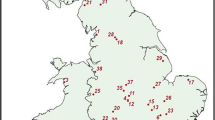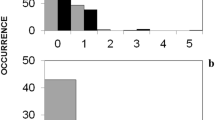Abstract
Intensification of agriculture and land consolidation policy induced the removal of most natural features from farmland, reducing the habitat of many wild species. Abandoned WWII bunkers, unaffected by land consolidation, are a potential shelter for wildlife and could be used as burrows by carnivores such as European badgers and red foxes.
We explored 182 abandoned bunkers in a farmland area in eastern France in summer 2016. Bunkers were located in crops, forests, or groves. Over a three-month period, signs of presence, the number and type of burrows inside the bunkers and in their immediate vicinity were noted. Environmental variables were obtained using GIS, and binomial models were created to reveal parameters influencing bunker use by badgers and foxes. The degree of bunkers burrowing was used as a co-variable. Twenty-one groves without bunkers were also studied in order to estimate the added value of bunkers in groves.
Badger and fox tracks were found on 34% of the sites, and burrows on 24% of them with similar rates for badgers and foxes. Animals used partially buried bunkers more than underground or overground bunkers. The sizes of annual crops and urban areas around the bunker were positively correlated with bunker use. The presence of a bunker in groves was positively correlated with the presence of burrows in groves.
As bunkers were widely used by badgers and foxes, they may improve conservation in intensive farming landscapes. We recommend the management of these ruins to facilitate the sustainable installation of a variety of species.




Similar content being viewed by others
References
(de) Redon L, Le Viol I, Jiguet F, Machon N, Scher O, Kerbiriou C (2015) Road network in an agrarian landscape: potential habitat, corridor or barrier for small mammals? Acta Oecol 62:58–65
Aaris-Sørensen J (1987) Past and present distribution of badgers Meles Meles in the Copenhagen area. Biol Conserv 41(3):159–165. https://doi.org/10.1016/0006-3207(87)90099-1
AFP. (2014). Forgotten war site now a bat cave [WWW document]. IOL. URL http://www.iol.co.za/news/forgotten-war-site-now-a-bat-cave-1672065
Anile ST, Bizzarri LO, Ragni BE (2009) Camera trapping the European wildcat (Felis Silvestris Silvestris) in Sicily (southern Italy): preliminary results. Hystrix Ital J Mammal 20:55–60
Ayers B, Parangoni I (2015) Industrial heritage in albania: an assessment. Ind Archaeol Rev 37(2):111–122. https://doi.org/10.1179/0309072815Z.00000000046
Bajrovic I, Satter J (2014) Albania: from bunkers to ballots. J Democr 25(1):142–153. https://doi.org/10.1353/jod.2014.0011
Balestrieri A, Cardarelli E, Pandini M, Remonti L, Saino N, Prigioni C (2016) Spatial organisation of European badger (Meles Meles) in northern Italy as assessed by camera-trapping. Eur J Wildl Res 62(2):219–226. https://doi.org/10.1007/s10344-016-0996-y
Benton TG, Vickery JA, Wilson JD (2003) Farmland biodiversity: is habitat heterogeneity the key? Trends Ecol Evol 18:182–188
Billeter R, Liira J, Bailey D, Bugter R, Arens P, Augenstein I, Aviron S, Baudry J, Bukacek R, Burel F, Cerny M, De Blust G, De Cock R, Diekötter T, Dietz H, Dirksen J, Dormann C, Durka W, Frenzel M, Hamersky R, Hendrickx F, Herzog F, Klotz S, Koolstra B, Lausch A, Le Coeur D, Maelfait JP, Opdam P, Roubalova M, Schermann A, Schermann N, Schmidt T, Schweiger O, Smulders MJM, Speelmans M, Simova P, Verboom J, Van Wingerden WKRE, Zobel M, Edwards PJ (2008) Indicators for biodiversity in agricultural landscapes: a pan-European study. J Appl Ecol 45:141–150
Bonfanti P, Fregonese A, Sigura M (1997) Landscape analysis in areas affected by land consolidation. Landsc Urban Plan 37(1-2):91–98. https://doi.org/10.1016/S0169-2046(96)00373-8
Butet A, Leroux ABA (2001) Effects of agriculture development on vole dynamics and conservation of Montagu’s harrier in western French wetlands. Biol Conserv 100(3):289–295. https://doi.org/10.1016/S0006-3207(01)00033-7
Ciechanowski M, Sachanowicz K (2014) Fat dormouse Glis glis (Rodentia: Gliridae) in Albania: synopsis of distributional records with notes on habitat use. Acta Zool Bulg 66:39–42
CIGAL. (2013). Données faune Alsace [WWW Document]. Coopération pour l’information géographique en Alsace. URL https://www.cigalsace.org/portail/
Crossland, D. & Schöne, S. (2007). From Wehrmacht to wildcats: world war II bunkers turn into wildlife haven [WWW document]. SPIEGEL ONLINE. URL http://www.spiegel.de/international/germany/from-wehrmacht-to-wildcats-world-war-ii-bunkers-turn-into-wildlife-haven-a-507880.html
Davison J, Huck M, Delahay RJ, Roper TJ (2008) Urban badger setts: characteristics, patterns of use and management implications. J Zool 275(2):190–200. https://doi.org/10.1111/j.1469-7998.2008.00424.x
Desjeux Y, Dupraz P, Kuhlman T, Paracchini ML, Michels R, Maigné E, Reinhard S (2014) Evaluating the impact of rural development measures on nature value indicators at different spatial levels: application to France and the Netherlands. Ecol Indic 59:41–61
DeVault TL, Olson ZH, Beasley JC, Rhodes OE (2011) Mesopredators dominate competition for carrion in an agricultural landscape. Basic Appl Ecol 12(3):268–274. https://doi.org/10.1016/j.baae.2011.02.008
Dondina O, Kataoka L, Orioli V, Bani L (2016) How to manage hedgerows as effective ecological corridors for mammals: a two-species approach. Agric Ecosyst Environ 231:283–290. https://doi.org/10.1016/j.agee.2016.07.005
Duelli P, Obrist MK (2003) Regional biodiversity in an agricultural landscape: the contribution of seminatural habitat islands. Basic Appl. Ecol. 4(2):129–138. https://doi.org/10.1078/1439-1791-00140
Evans LE, Ardia DR, Flux JEC (2009) Breeding synchrony through social stimulation in a spatially segregated population of European starlings. Anim Behav 78(3):671–675. https://doi.org/10.1016/j.anbehav.2009.05.031
Foley JA, Defries R, Asner GP, Barford C, Bonan G, Carpenter SR, Chapin FS, Coe MT, Daily GC, Gibbs HK, Helkowski JH, Holloway T, Howard EA, Kucharik CJ, Monfreda C, Patz JA, Prentice IC, Ramankutty N, Snyder PK (2005) Global consequences of land use. Science 309(80):570–574
Grashof-Bokdam CJ, van Langevelde F (2005) Green veining: landscape determinants of biodiversity in European agricultural landscapes. Landsc Ecol 20(4):417–439. https://doi.org/10.1007/s10980-004-5646-1
Hoffmann, M. & Sillero-Zubiri, C. (2016). Vulpes Vulpes, red fox. IUCN Red List Threat. Species 2016, e.T23062A4, 1–10
Kaufmann J, Jurga R (1999) Fortress Europe: European fortifications of world war II, 1st edn. First Da Capo Press
König C (2013) Les ravageurs, menace pour nos céréales. p 1–24. Retrieved from https://fr.cdn.v5.futura-sciences.com/builds/pdf/dossier/1000-1999/1658-ravageurs-menace-noscereales-6f0ee2c.pdf. Accessed 08 Aug 2016
Kranz, A., Abramov, A.V., Herrero, J. & Maran, T. (2016). Meles Meles. IUCN Red List Threat. Species 2016, 8235, e.T29673A45203002
Kurek P, Kapusta P, Holeksa J (2013) Burrowing by badgers (Meles Meles) and foxes (Vulpes Vulpes) changes soil conditions and vegetation in a European temperate forest. Ecol Res 29:1–11
Macdonald DW, Newman C, Dean J, Buesching CD, Johnson PJ (2004) The distribution of Eurasian badger, Meles meles, setts in a high-density area: field observations contradict the sett dispersion hypothesis. Oikos 106(2):295–307. https://doi.org/10.1111/j.0030-1299.2004.12879.x
Marton M, Markolt F, Szabo L, Kozak L, Lanszki J, Patko L, Heltai M (2016) Den site selection of the European badger, Meles Meles and the red fox. Vulpes vulpes in Hungary FOLIA Zool 65:72–79
Maxwell SL, Fuller RA, Brooks TM, Watson JEM (2016) The ravages of guns, nets and bulldozers. Nature 536:146–145
Meia J-S, Weber J-M (1995) Home ranges and movements of red foxes in central Europe: stability despite environmental changes. Can J Zool 73(10):1960–1966. https://doi.org/10.1139/z95-230
Mermy, D.C., Guignat, H.S., Zammit, R., Heckenmeyer, E. & Lizée, M. (2011) p 1–112. Inventaire départemental des cavités souterraines hors mines du Bas-Rhin. Inventaire départemental des cavités souterraines hors mines du Bas-Rhin. Retrieved from http://www.google.fr/url?sa=t&rct=j&q=&esrc=s&source=web&cd=1&cad=rja&uact=8&ved=0ahUKEwiJsefL4tbXAhVCqQKHQHoDX4QFggmMAA&url=http%3A%2F%2Finfoterre.brgm.fr%2Frapports%2FRP-60315-FR.pdf&usg=AOvVaw2KgQyYuz9pW5ISScudIuGD. Accessed 10 Dec 2015
Nowicki F, Dadu L, Carsignol J, Bretaud J-F, Bielsa S (2008) Rapport bibliographique : Routes et chiroptères Etat des connaissances. Les Rapp:1–253
Odonat : Office des données naturalistes du Grand-Est. (2017). Atlas des espèces d’Alsace [WWW Document]. www.faune-alsace.org . URL http://www.faune-alsace.org/index.php?m_id=620
Poschlod P, Bakker JP, Kahmen S (2005) Changing land use and its impact on biodiversity. Basic Appl. Ecol. 6(2):93–98. https://doi.org/10.1016/j.baae.2004.12.001
Remonti L, Balestrieri A, Prigioni C (2006) Factors determining badger Meles Meles sett location in agricultural ecosystems of NW Italy. Folia Zool 55(1):19–27
Ritchie EG, Elmhagen B, Glen AS, Letnic M, Ludwig G, McDonald RA (2012) Ecosystem restoration with teeth: what role for predators? Trends Ecol. Evolution 27:265–271
Robinson RA, Sutherland WJ (2002) Post-war changes in arable farming and biodiversity in great Britain. J Appl Ecol 39(1):157–176. https://doi.org/10.1046/j.1365-2664.2002.00695.x
Rondinini C, Ercoli V, Boitani L (2006) Habitat use and preference by polecats (Mustela putorius L.) in a Mediterranean agricultural landscape. J Zool 269:213–219
Roper TJ (1992) The structure and function of badger setts. J Zool 227(4):691–694. https://doi.org/10.1111/j.1469-7998.1992.tb04425.x
Roper TJ, Tait AI, Fee D, Christian SF (1991) Internal structure and contents of three badger ( Meles Meles ) setts. J Zool 225(1):115–124. https://doi.org/10.1111/j.1469-7998.1991.tb03805.x
Sachanowicz K, Zub K (2002) Numbers of hibernating Barbastella Barbastellus (Schreber, 1774) (Chiroptera, Vespertilionidae) and thermal conditions in military bunkers. Mamm Biol - Zeitschrift für Säugetierkd 67:179–184
Sekercioglu CH (2006) Increasing awareness of avian ecological function. Trends Ecol Evol 21(8):464–471. https://doi.org/10.1016/j.tree.2006.05.007
Sheperd BF, Swihart RK (1995) Spatial dynamics of fox squirrels ( Sciurus Niger ) in fragmented landscapes. Can J Zool 73(11):2098–2105. https://doi.org/10.1139/z95-247
Théou P, Bego F (2013). Etude des populations de chiroptères de l’île de Sazani. Note naturaliste Initiative PIM 12p. Retrieved from http://www.researchgate.net/profile/Philippe_Theou/publication/299505687_Etude_des_populations_de_chiropteres_de_l%27ile_de_Sazani_Note_naturaliste_Initiative_PIM/links/56fc0ef208aedes-populations-de-chiropteres-de-lile-de-Sazani-Note-naturaliste-Initiative-PIM.pdf?origin=publication_detail. Accessed 08 Aug 2016
Tscharntke T, Klein AM, Kruess A, Steffan-Dewenter I, Thies C (2005) Landscape perspectives on agricultural intensification and biodiversity - ecosystem service management. Ecol Lett 8(8):857–874. https://doi.org/10.1111/j.1461-0248.2005.00782.x
Velli E, Bologna MA, Silvia C, Ragni B, Randi E (2015) Non-invasive monitoring of the European wildcat (Felis Silvestris Silvestris Schreber, 1777): comparative analysis of three different monitoring techniques and evaluation of their integration. Eur J Wildl Res 61(5):657–668. https://doi.org/10.1007/s10344-015-0936-2
Warchałowski M, Łupicki D, Cichocki J, Pietraszko M, Rusek A, Zawadzka A, Nikodem M (2013) Zimowanie nietoperzy Chiroptera w wybranych obiektach wolno stojących Frontu Fortecznego Łuku Odry i Warty. Kulon 18:139–147
van der Well, L. & van Beveren, A. (2016). Bunkersite.com [WWW document]. URL http://bunkersite.com/index.php
Wretenberg J, Pärt T, Berg Å (2010) Changes in local species richness of farmland birds in relation to land-use changes and landscape structure. Biol Conserv 143(2):375–381. https://doi.org/10.1016/j.biocon.2009.11.001
Zduniak P, Czechowski P, Jedro G (2011) The effect of nesting habitat on reproductive output of the barn swallow (Hirundo Rustica). A comparative study of populations from atypical and typical nesting habitats in western Poland BELGIAN J Zool 141:38–43
Zollner PA (2000) Comparing the landscape level perceptual abilities of forest sciurids in fragmented agricultural landscapes. Landsc Ecol 15(6):523–533. https://doi.org/10.1023/A:1008154532512
Acknowledgements
We thank all the students who participated in this study and the anonymous reviewers for their comments on the previous version of this manuscript. We also thank Joanna Lignot and Lana Petrod for the English editing.
Author information
Authors and Affiliations
Contributions
All authors approve this version of the manuscript. They agree to be accountable for the aspects of the work that they conducted, and will ensure that any questions related to the accuracy or integrity of any part of their work are appropriately investigated and resolved. JJ conceived the idea and design methodology; JJ, DW, NG and LG collected the data; JJ and LG carried out data analysis; JJ, YH and FB organised the writing of the manuscript. All authors played an active part in the drafting of the manuscript and gave their final approval for publication.
Corresponding author
Ethics declarations
Role of the funding source
This study was conducted though the CERISE project research and was funded by the French Minister of Ecology (DREAL Alsace) and the Departmental Council of the Bas-Rhin (CD67). They had no role in the study design, writing, collection, analysis and interpretation of data. They agree to the publication of this study.
Rights and permissions
About this article
Cite this article
Jumeau, J., Wolf, D., Guthmann, L. et al. The use of military bunkers by the European badger and red fox in Western Europe. Urban Ecosyst 21, 395–403 (2018). https://doi.org/10.1007/s11252-017-0721-y
Published:
Issue Date:
DOI: https://doi.org/10.1007/s11252-017-0721-y




